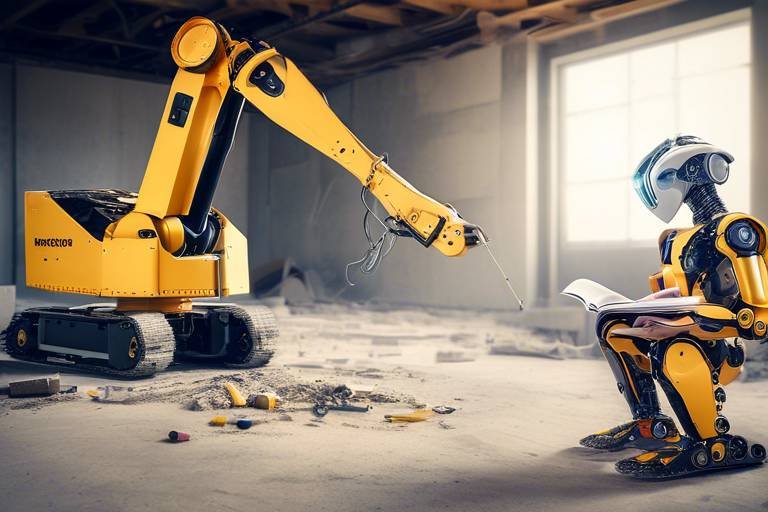How Robotics is Transforming Logistics Operations
The logistics industry is undergoing a seismic shift, and at the heart of this transformation is robotics technology. From warehouses to distribution centers, robots are becoming integral to operations, reshaping how goods are stored, moved, and delivered. Imagine a bustling warehouse where autonomous machines glide seamlessly between aisles, picking and packing items with precision and speed. This isn't science fiction; it's the new reality of logistics. As companies seek to enhance their efficiency and reduce costs, the adoption of robotics is not just an option; it’s becoming a necessity.
Why is this happening? Well, there are several driving forces behind the rise of robotics in logistics. First, the demand for faster delivery times has skyrocketed, especially with the advent of e-commerce giants like Amazon setting the bar high. Customers now expect their orders to arrive almost instantaneously, and robotics is stepping up to meet these expectations. Furthermore, the ongoing labor shortages in many regions have pushed companies to look for automated solutions to fill the gaps. By integrating robots into their operations, businesses can not only maintain productivity but also free up human workers to focus on more complex tasks that require a personal touch.
As we dive deeper into the world of logistics, it’s essential to understand the various types of robotics being utilized. The landscape is diverse, featuring an array of machines designed for specific tasks. For instance, Autonomous Mobile Robots (AMRs) are revolutionizing warehouse operations by navigating independently through complex environments. Robotic arms are streamlining repetitive tasks like picking and packing, while drones are taking inventory management to new heights—literally! Each type of robot plays a unique role, contributing to a more efficient and productive supply chain.
In conclusion, the integration of robotics in logistics is not merely a trend; it is a fundamental shift that is reshaping the industry. As we explore the various innovations and benefits that robotics brings to logistics operations, it's clear that the future is bright. However, with every advantage comes a set of challenges that must be navigated carefully. Understanding these dynamics will be crucial for businesses looking to thrive in this rapidly evolving landscape.
- How do robotics improve efficiency in logistics?
Robotics enhance efficiency by automating repetitive tasks, reducing human error, and speeding up operations, allowing for faster processing and delivery of goods. - What are the main types of robots used in logistics?
The main types of robots include Autonomous Mobile Robots (AMRs), robotic arms, and drones, each serving distinct functions within the supply chain. - What challenges do companies face when implementing robotics?
Challenges include high initial costs, integration complexities with existing systems, and the need for ongoing maintenance and support. - Will robotics replace human workers in logistics?
While robotics will automate certain tasks, they are more likely to augment human roles, allowing workers to focus on more strategic and complex responsibilities.

The Rise of Robotics in Logistics
The world of logistics is undergoing a remarkable transformation, and at the heart of this change is the rise of robotics technology. Once considered a futuristic concept, robotics has swiftly moved from the realm of science fiction into reality, reshaping how companies manage their supply chains. What’s driving this revolution? Well, a combination of factors is at play, including the need for increased efficiency, the demand for faster delivery times, and the ever-growing complexity of global supply chains.
As businesses strive to remain competitive, they are increasingly looking to automation as a solution. Robotics offers the promise of not just maintaining but enhancing operational capabilities. Companies are integrating robots into their logistics operations, and this integration is not merely an upgrade; it’s a complete overhaul of traditional processes. Imagine a bustling warehouse where autonomous mobile robots (AMRs) glide effortlessly between aisles, transporting goods without human intervention. This is not just a dream; it’s a reality that many companies are beginning to embrace.
Furthermore, advancements in artificial intelligence (AI) and machine learning are enabling robots to perform tasks that were once thought to require human intelligence. For instance, robots can now analyze inventory levels in real-time, predict stock shortages, and even optimize delivery routes. These capabilities allow logistics companies to respond more swiftly to market demands, reducing lead times and improving customer satisfaction. The integration of robotics is not just a trend; it’s a necessary evolution in the logistics sector.
However, the rise of robotics in logistics is not without its challenges. Companies must navigate the complexities of integrating these technologies into existing systems. Initial costs can be daunting, and there’s often a steep learning curve associated with training staff to work alongside robots. Yet, the potential benefits far outweigh these challenges. As the industry continues to evolve, more businesses are recognizing that investing in robotics is essential for long-term success.
In summary, the rise of robotics in logistics is a game-changer. It’s about more than just efficiency; it’s about creating a future-proof supply chain that can adapt to the rapid changes in consumer demands and market conditions. As technology continues to advance, we can expect robotics to play an even more significant role in logistics operations, paving the way for a smarter, more efficient industry.

Types of Robotics Used in Logistics
In the ever-evolving landscape of logistics, robotics has emerged as a game-changer, introducing a range of innovative solutions that streamline operations and enhance productivity. Various types of robots are now being employed in logistics, each designed to tackle specific tasks and challenges within the supply chain. Understanding these categories is crucial for businesses looking to leverage technology effectively. Let's dive into the major types of robotics that are making waves in the logistics sector.
One of the most prominent categories is Autonomous Mobile Robots (AMRs). These robots navigate through warehouses and distribution centers independently, utilizing sophisticated sensors and mapping technologies to move goods efficiently. Unlike traditional automated guided vehicles (AGVs), AMRs can adapt to dynamic environments, making them ideal for modern logistics operations. They excel in tasks such as transporting materials from one location to another, significantly reducing the time and effort required for manual handling.
Another vital type is the Robotic Arm. These machines are designed to automate repetitive tasks such as picking, packing, and sorting items. Equipped with advanced gripping mechanisms and precision control, robotic arms can handle a wide variety of products, from delicate items to heavy packages. Their ability to work tirelessly and with high accuracy not only boosts productivity but also minimizes the risk of human error, which can be detrimental in logistics.
Additionally, drones are carving out a niche in logistics, particularly in inventory management and last-mile delivery. Drones can quickly survey large warehouse spaces, providing real-time data on stock levels and helping to maintain accurate inventory records. In urban environments, they offer a promising solution for delivering packages directly to customers, bypassing traffic and reducing delivery times.
To give you a clearer picture of these robotics types, here’s a quick comparison:
| Type of Robot | Primary Function | Key Benefits |
|---|---|---|
| Autonomous Mobile Robots (AMRs) | Transport materials within facilities | Increased efficiency, reduced labor costs |
| Robotic Arms | Automate picking and packing tasks | High accuracy, reduced errors, enhanced productivity |
| Drones | Inventory management and last-mile delivery | Speedy deliveries, real-time inventory tracking |
Each of these robotic types plays a significant role in transforming logistics operations, and their integration into supply chains is not just a trend but a necessity for staying competitive. As companies continue to adopt these technologies, we can expect to see even more innovative applications emerge, further enhancing operational efficiencies and driving down costs.
- What are Autonomous Mobile Robots (AMRs)? AMRs are robots that can navigate and perform tasks in a logistics environment without human intervention.
- How do robotic arms improve warehouse operations? Robotic arms automate repetitive tasks, increasing speed and accuracy while reducing the risk of human error.
- What role do drones play in logistics? Drones are used for inventory management and can deliver packages quickly, especially in urban areas.

Autonomous Mobile Robots (AMRs)
Autonomous Mobile Robots, or AMRs, are rapidly changing the landscape of warehouse operations and logistics management. These sophisticated machines are designed to navigate their environments independently, utilizing advanced sensors, cameras, and artificial intelligence to make real-time decisions. Imagine a fleet of robots gliding through a warehouse, seamlessly transporting goods without the need for human intervention. This is not science fiction; it’s the reality of modern logistics!
One of the most remarkable features of AMRs is their ability to optimize material handling and transportation within logistics facilities. By efficiently moving products from one location to another, they significantly reduce the time and labor costs associated with traditional manual handling. Furthermore, AMRs can operate around the clock, ensuring that operations continue smoothly without the interruptions that human workers might face, such as breaks or shift changes.
But how do AMRs achieve this level of efficiency? Here are some key capabilities:
- Navigation: AMRs use sophisticated mapping technologies, such as LIDAR and computer vision, to create real-time maps of their surroundings, allowing them to navigate complex environments.
- Obstacle Detection: Equipped with advanced sensors, AMRs can detect obstacles in their path and navigate around them, ensuring safe operation in busy warehouse settings.
- Task Management: AMRs can be programmed to execute specific tasks, such as picking up items from designated locations and delivering them to packing stations, all while communicating with other robots and systems.
The benefits of incorporating AMRs into logistics operations are numerous. For instance, they can lead to a dramatic increase in operational efficiency by streamlining workflows and reducing the time taken to move goods. Additionally, AMRs enhance safety within warehouses by taking over dangerous tasks that could pose risks to human workers, such as navigating through narrow aisles or lifting heavy items.
However, deploying AMRs is not without its challenges. Companies must consider factors such as integration complexity, as existing systems and processes may need to be adapted to accommodate these new technologies. Moreover, the initial investment required to purchase and implement AMRs can be significant. Despite these hurdles, the long-term benefits often outweigh the initial costs, making AMRs a worthwhile investment for many logistics companies.
In summary, AMRs are not just a trend; they are a transformative force in logistics. As technology continues to evolve, we can expect these robots to become even more capable and integral to the supply chain, paving the way for a future where efficiency and productivity are vastly improved.
1. What are Autonomous Mobile Robots (AMRs)?
AMRs are robots that navigate their environments independently to perform tasks such as transporting goods in warehouses and logistics facilities.
2. How do AMRs enhance efficiency in logistics?
AMRs optimize material handling by reducing labor costs, increasing operational speed, and allowing for 24/7 operation without breaks.
3. What challenges are associated with implementing AMRs?
Challenges include integration complexity with existing systems and the initial costs of purchasing and deploying the robots.

Benefits of AMRs
Autonomous Mobile Robots (AMRs) are not just a technological fad; they are a game-changer in the logistics industry. One of the most significant benefits of AMRs is their ability to reduce labor costs. By taking over repetitive tasks such as transporting goods within a warehouse, these robots allow human workers to focus on more complex and strategic activities. Imagine a warehouse where robots handle the heavy lifting, while employees can concentrate on optimizing inventory or enhancing customer service. This shift not only boosts productivity but also leads to a more engaged workforce.
Another key advantage of AMRs is the enhanced safety they bring to logistics operations. With their advanced sensors and navigation systems, AMRs can operate in busy environments without colliding with obstacles or causing accidents. This technological prowess significantly decreases the risk of workplace injuries, creating a safer environment for human workers. In industries where safety is paramount, the introduction of AMRs can be a transformative step.
Moreover, AMRs contribute to improved operational efficiency. They can work around the clock, tirelessly transporting goods without the need for breaks or downtime. This continuous operation leads to faster processing times and reduced lead times for order fulfillment. For instance, a company utilizing AMRs can expect to see a notable decrease in the time it takes to move products from one location to another, thereby enhancing overall supply chain responsiveness.
Let’s not forget about the data collection capabilities of AMRs. These robots are equipped with advanced analytics tools that allow them to gather valuable data on inventory movement and warehouse operations. This data can be analyzed to identify patterns, optimize routes, and improve overall efficiency. With such insights, companies can make informed decisions that drive further enhancements in their logistics processes.
In summary, the benefits of integrating AMRs into logistics operations are profound:
- Cost Reduction: Lower labor costs and increased productivity.
- Safety: Minimized workplace accidents and injuries.
- Efficiency: Faster processing and reduced lead times.
- Data Insights: Enhanced decision-making through analytics.
As we move forward, the adoption of AMRs will likely become a standard practice in logistics, leading to a more efficient, safe, and data-driven industry. Companies that embrace this technology will not only stay competitive but also set the stage for future innovations in supply chain management.
1. What are Autonomous Mobile Robots (AMRs)?
AMRs are robots capable of navigating their environment independently, using sensors and AI to transport goods within logistics facilities.
2. How do AMRs improve safety in warehouses?
AMRs reduce the risk of accidents by operating with advanced navigation systems that prevent collisions and ensure safe movement around human workers.
3. Can AMRs work alongside human employees?
Yes, AMRs are designed to complement human workers by taking over repetitive tasks, allowing employees to focus on more complex and strategic operations.
4. What types of tasks can AMRs perform?
AMRs are primarily used for material handling, including transporting goods, moving inventory, and even assisting in order fulfillment processes.
5. Are AMRs cost-effective for logistics companies?
Absolutely! By reducing labor costs and increasing efficiency, AMRs can lead to significant savings and a higher return on investment for logistics operations.

Challenges of Implementing AMRs
While the integration of Autonomous Mobile Robots (AMRs) into logistics operations brings numerous benefits, it also presents a unique set of challenges that companies must navigate. One of the primary hurdles is the complexity of integration. AMRs need to be seamlessly integrated with existing warehouse management systems and operational workflows. This often requires significant adjustments to current processes, which can be daunting for organizations that are accustomed to traditional methods.
Moreover, the initial costs associated with deploying AMRs can be a considerable barrier. These costs encompass not only the purchase of the robots themselves but also the necessary infrastructure upgrades, software integration, and training for staff. Businesses must weigh these upfront investments against the long-term savings and efficiency gains that robotics can offer. This leads to the question: is the initial financial outlay justified by the potential return on investment?
Another challenge is the need for ongoing maintenance and support. AMRs, like any piece of technology, require regular maintenance to ensure they operate at peak performance. This can involve software updates, battery replacements, and troubleshooting any technical issues that arise. Companies must be prepared to allocate resources for this ongoing support, which can strain smaller operations or those with limited budgets.
Additionally, the workforce impact cannot be overlooked. The introduction of AMRs may lead to concerns among employees regarding job security. While these robots can handle repetitive tasks, they also free up human workers to focus on more complex and value-added roles. To mitigate fears and promote a positive work culture, companies should prioritize transparent communication and offer retraining opportunities for staff to transition into new roles that complement the technology.
In summary, while the deployment of AMRs can significantly enhance operational efficiency in logistics, companies face challenges such as integration complexity, initial costs, ongoing maintenance, and workforce implications. Addressing these challenges head-on with strategic planning and clear communication can pave the way for a successful transition into a more automated future.
- What are Autonomous Mobile Robots (AMRs)?
AMRs are robots that can navigate and perform tasks in a warehouse or logistics environment without human intervention. - What are the main benefits of using AMRs?
Benefits include increased efficiency, reduced labor costs, and enhanced safety in logistics operations. - How do companies overcome the challenges of implementing AMRs?
By investing in proper training, maintaining clear communication, and planning for integration with existing systems. - Are AMRs suitable for all types of warehouses?
While they can benefit many operations, the suitability of AMRs depends on the specific layout and processes of the warehouse.

Robotic Arms in Warehousing
Robotic arms are becoming the backbone of modern warehousing operations, transforming the way tasks are executed and significantly enhancing productivity. These sophisticated machines are designed to mimic the movements of a human arm, allowing them to perform a variety of functions with precision and speed. From picking and packing to sorting and assembling, robotic arms are streamlining processes that were once labor-intensive and time-consuming.
Imagine a bustling warehouse filled with countless items, where human workers are tirelessly picking products from shelves and packing them for shipment. Now, picture robotic arms seamlessly gliding along conveyor belts, deftly selecting items and placing them into boxes with remarkable accuracy. This is not a scene from a futuristic movie; it's the reality of today's logistics operations. By automating repetitive tasks, robotic arms free up human workers to focus on more complex and strategic roles, ultimately leading to a more efficient workforce.
One of the standout features of robotic arms is their ability to work in harmony with other automated systems. For instance, when integrated with Autonomous Mobile Robots (AMRs), robotic arms can receive items from these mobile units, perform their tasks, and then return the completed orders to the AMRs for delivery. This synergy creates a seamless flow of operations, reducing bottlenecks and ensuring that products are processed quickly and accurately.
Moreover, the precision of robotic arms minimizes the risk of human error, which is crucial in maintaining high standards of order accuracy. In a world where customers expect rapid delivery and flawless service, the ability to reduce mistakes can set a company apart from its competitors. According to a recent study, warehouses that implemented robotic arms reported a 30% increase in order accuracy, demonstrating the tangible benefits of this technology.
However, the integration of robotic arms into warehousing is not without its challenges. The initial investment can be substantial, and companies must consider the costs associated with training staff to work alongside these machines. Additionally, maintaining and troubleshooting robotic systems requires specialized knowledge, which can be a hurdle for some organizations. Nevertheless, the long-term benefits often outweigh the initial challenges, making robotic arms a worthwhile investment for many logistics companies.
In conclusion, robotic arms are revolutionizing warehousing operations by enhancing efficiency, improving accuracy, and allowing human workers to focus on more critical tasks. As technology continues to advance, we can expect these machines to become even more sophisticated, further optimizing logistics processes and setting new standards in the industry.
- What are robotic arms used for in warehousing? Robotic arms are primarily used for tasks such as picking, packing, sorting, and assembling products in a warehouse setting.
- How do robotic arms improve efficiency? They automate repetitive tasks, reduce human error, and can operate continuously without breaks, leading to faster processing times.
- What are the challenges of implementing robotic arms? The main challenges include high initial costs, the need for specialized training, and maintenance requirements.
- Are robotic arms safe to use? Yes, when properly implemented and maintained, robotic arms are designed with safety features to work alongside human workers without posing significant risks.

Impact on Supply Chain Efficiency
The integration of robotics into logistics operations is nothing short of a game-changer. With the ability to automate various tasks, robotics significantly enhances supply chain efficiency, transforming the way businesses operate. Imagine a world where products move seamlessly from one point to another, with minimal human intervention. This vision is becoming a reality as companies adopt robotic solutions that streamline processes, reduce lead times, and improve inventory management.
One of the most notable impacts of robotics on supply chain efficiency is the reduction in lead times. Traditional logistics operations often involve complex manual processes that can slow down the movement of goods. However, with the introduction of robots, tasks such as sorting, picking, and packing can be completed at lightning speed. For instance, autonomous mobile robots (AMRs) can swiftly navigate through warehouses, delivering items to designated locations without the delays associated with human labor. This efficiency not only speeds up the overall process but also allows companies to respond quicker to customer demands.
Furthermore, robotics enhances inventory management, which is crucial for maintaining optimal stock levels. By utilizing advanced algorithms and real-time data, robotic systems can accurately track inventory, reducing the chances of overstocking or stockouts. This capability is particularly important in industries where demand can fluctuate dramatically. With robots managing inventory, businesses can achieve a more balanced supply chain, ensuring that products are available when needed without tying up excessive capital in stock.
To illustrate the impact of robotics on supply chain efficiency, consider the following table that highlights key performance indicators (KPIs) before and after the implementation of robotic systems:
| KPI | Before Robotics | After Robotics |
|---|---|---|
| Average Order Fulfillment Time | 48 hours | 24 hours |
| Inventory Accuracy Rate | 85% | 98% |
| Labor Costs | $100,000/month | $70,000/month |
As shown in the table, the implementation of robotics leads to a significant decrease in order fulfillment time and a remarkable increase in inventory accuracy. Additionally, the reduction in labor costs demonstrates how automation can lead to substantial financial savings for businesses.
Moreover, the integration of robotics fosters a safer work environment. By automating hazardous tasks, companies can minimize workplace accidents and injuries, creating a more productive atmosphere. Employees can focus on higher-value tasks that require critical thinking and creativity, rather than repetitive manual labor. This shift not only boosts morale but also enhances overall productivity, as workers are empowered to contribute to more strategic initiatives within the organization.
In conclusion, the impact of robotics on supply chain efficiency is profound and far-reaching. From reducing lead times and improving inventory management to lowering labor costs and enhancing workplace safety, the benefits are clear. As technology continues to advance, we can expect even greater innovations in robotics that will further optimize logistics operations and redefine the future of supply chain management.
- What types of robots are commonly used in logistics? Autonomous mobile robots, robotic arms, and drones are among the most common types used in logistics operations.
- How do robotics improve order accuracy? Robotics utilize precise algorithms and automated systems to minimize human error, ensuring accurate order fulfillment.
- What are the initial costs associated with implementing robotics in logistics? While initial costs can be high, the long-term savings in labor and increased efficiency often justify the investment.
- Will robots replace human jobs in logistics? Robots are designed to complement human workers, taking over repetitive tasks while allowing employees to focus on more complex responsibilities.

Cost Reduction through Automation
In the fast-paced world of logistics, every penny counts. Companies are constantly searching for ways to cut costs while maintaining high levels of service. Enter automation, the game changer that is revolutionizing the logistics sector. By incorporating robotics into their operations, businesses are not just enhancing efficiency; they are also achieving significant cost reductions that can transform their bottom line.
One of the most compelling advantages of automation is the reduction in labor costs. Traditional warehousing relies heavily on human labor for tasks such as picking, packing, and sorting. By deploying robots, companies can minimize their reliance on manual labor. This shift not only reduces payroll expenses but also mitigates the costs associated with training and employee turnover. In fact, studies have shown that companies can save up to 30% on labor costs by integrating robotic systems into their workflows.
Moreover, automation leads to improved operational efficiency. Robots can operate around the clock without the need for breaks, which means they can handle more tasks in less time compared to human workers. For instance, a robotic arm can pick and pack items at a speed that is simply unmatched by a human worker. This increased throughput not only boosts productivity but also allows companies to fulfill orders faster, leading to higher customer satisfaction and repeat business.
Additionally, automation helps in reducing errors that often lead to costly mistakes. In logistics, even a small error in order fulfillment can result in significant financial losses. Robotics technology, equipped with advanced sensors and software, ensures that tasks are performed with high precision. This level of accuracy reduces the likelihood of returns and complaints, ultimately saving companies money. For example, the implementation of automated picking systems has been shown to decrease order errors by as much as 70%.
To illustrate the financial impact of automation in logistics, consider the following table:
| Cost Factor | Before Automation | After Automation | Percentage Reduction |
|---|---|---|---|
| Labor Costs | $500,000 | $350,000 | 30% |
| Error Costs | $100,000 | $30,000 | 70% |
| Operational Costs | $300,000 | $210,000 | 30% |
As shown in the table, the transition to automation can lead to substantial savings across various cost factors. These reductions not only enhance profitability but also create a competitive advantage in a crowded marketplace.
In conclusion, the integration of robotics into logistics operations is not merely a trend; it is a strategic move that results in cost reductions and improved efficiency. As companies continue to embrace automation, those who adapt will likely see enhanced financial performance and a stronger position in the industry. So, if you're in logistics and haven't considered robotics yet, it might be time to rethink your strategy!
- What types of robots are commonly used in logistics?
Common types include autonomous mobile robots (AMRs), robotic arms, and drones, each serving different functions in the logistics process. - How much can companies save by implementing robotics?
Companies can save up to 30% on labor costs and reduce order errors by as much as 70% through automation. - Are there challenges to implementing robotics in logistics?
Yes, challenges include integration complexity and initial investment costs. However, the long-term benefits often outweigh these hurdles.

Improving Order Accuracy
In the fast-paced world of logistics, order accuracy is paramount. It’s not just about getting the right product to the right place; it’s about ensuring that customers receive exactly what they ordered, when they ordered it. Imagine ordering a new gadget online, only to find that the wrong model arrives at your doorstep. Frustrating, right? This is where robotics technology steps in, transforming the way businesses handle order fulfillment.
Robotics plays a crucial role in enhancing order accuracy through several innovative mechanisms. For starters, automated systems equipped with advanced sensors and artificial intelligence can scan and verify items with incredible precision. This level of accuracy minimizes human error, which is often the culprit behind order discrepancies. When robots are tasked with picking and packing, they rely on data-driven algorithms to ensure that each item is correctly identified and sorted.
Moreover, the implementation of robotic arms in warehouses allows for consistent and repeatable actions that humans may struggle to perform with the same level of accuracy. These robotic systems can handle various sizes and shapes of products, ensuring that each item is handled delicately and correctly. For instance, a robotic arm can pick a fragile item and place it in a box without the risk of damage, something that can be challenging for human workers, especially during high-volume periods.
Another significant advantage of robotics in improving order accuracy is the integration of real-time tracking systems. These systems provide immediate feedback on inventory levels and order statuses, allowing businesses to maintain precise stock counts. When a robot picks an item, it updates the inventory database instantly, reducing the chances of stockouts or overstock situations. This real-time data is invaluable for logistics managers, enabling them to make informed decisions quickly.
To illustrate the impact of robotics on order accuracy, consider the following table that compares traditional fulfillment methods with robotic-assisted processes:
| Aspect | Traditional Fulfillment | Robotic-Assisted Fulfillment |
|---|---|---|
| Human Error Rate | High | Low |
| Speed of Order Processing | Moderate | High |
| Inventory Management | Manual | Automated |
| Cost of Errors | High | Low |
As shown in the table, the shift from traditional methods to robotic-assisted fulfillment results in a dramatic reduction in human error rates and processing times. This not only enhances customer satisfaction but also reduces costs associated with returns and re-shipments.
In conclusion, the integration of robotics in logistics operations is a game-changer for improving order accuracy. By minimizing human error, automating inventory management, and leveraging real-time data, companies can ensure that they meet customer expectations consistently. As we continue to embrace technological advancements, the future of logistics looks bright, with robotics leading the charge towards greater precision and efficiency.
- What is the role of robotics in logistics? Robotics enhances efficiency, accuracy, and speed in logistics operations, helping businesses meet customer demands more effectively.
- How do robots improve order accuracy? Robots reduce human error through automated picking and packing processes, real-time inventory tracking, and precise handling of products.
- What are the benefits of using robotic arms in warehouses? Robotic arms automate repetitive tasks, improve speed, enhance precision, and reduce the risk of product damage during handling.
- Are there challenges in implementing robotics in logistics? Yes, challenges include integration complexity, initial costs, and the need for training staff to work alongside robotic systems.

Future Trends in Robotics for Logistics
The logistics industry is on the brink of a revolutionary transformation, driven by the rapid advancements in robotics technology. As we look ahead, several exciting trends are emerging that promise to reshape how logistics operations are conducted. One of the most significant trends is the integration of artificial intelligence (AI) into robotic systems. This combination allows robots to not only perform tasks but also to learn from their environments, making them smarter and more efficient over time. Imagine a warehouse where robots can adapt to changes in layout or inventory levels without human intervention—this is the future we are heading towards.
Another trend gaining momentum is the rise of collaborative robots, or cobots, which are designed to work alongside human workers. These robots can take over repetitive tasks, freeing up human employees to focus on more complex and strategic activities. This partnership enhances productivity and safety in the workplace, as cobots are equipped with advanced sensors to ensure they operate safely in close proximity to humans. The synergy between human intelligence and robotic efficiency can lead to unprecedented levels of operational success.
Moreover, advancements in robotic capabilities, such as improved mobility and dexterity, are paving the way for more versatile applications in logistics. For instance, robots are now capable of navigating complex environments, handling a wider variety of products, and performing delicate tasks that were once thought impossible. This increased versatility means that logistics companies can automate a broader range of processes, from sorting and packing to delivery.
To illustrate these trends, consider the following table that highlights the key innovations and their potential impacts on logistics:
| Trend | Description | Potential Impact |
|---|---|---|
| AI Integration | Robots equipped with AI can learn and adapt to new tasks. | Increased efficiency and reduced operational errors. |
| Collaborative Robots | Cobots work alongside humans to enhance productivity. | Improved safety and job satisfaction for human workers. |
| Enhanced Mobility | Robots can navigate complex environments with ease. | Greater flexibility in warehouse layouts and operations. |
Furthermore, the future of logistics robotics will likely see a greater emphasis on sustainability. With the growing concern over environmental impact, companies are looking for ways to reduce their carbon footprints. Robotics can play a crucial role in achieving this goal by optimizing routes for deliveries, reducing waste in packaging, and minimizing energy consumption in warehouse operations. The green logistics movement is gaining traction, and robotics will be at the forefront of this change.
In conclusion, the future trends in robotics for logistics are not just about automation; they are about creating a more efficient, collaborative, and sustainable industry. As these technologies continue to evolve, businesses that embrace them will likely lead the way in operational excellence and customer satisfaction. The logistics landscape is changing, and those who adapt will thrive in this new era.
- What are collaborative robots (cobots)? Cobots are designed to work alongside human workers, enhancing productivity and safety in logistics operations.
- How does AI integration benefit logistics robotics? AI enables robots to learn and adapt, increasing efficiency and minimizing operational errors.
- What impact do robotics have on sustainability in logistics? Robotics can optimize delivery routes and reduce waste, contributing to greener logistics practices.
Frequently Asked Questions
- What are the main benefits of using robotics in logistics?
Robotics in logistics offers numerous benefits, including increased efficiency, cost savings, and improved safety. By automating repetitive tasks, companies can streamline operations, reduce lead times, and enhance overall productivity. This leads to faster order fulfillment and better customer satisfaction.
- What types of robots are commonly used in logistics?
There are several types of robots utilized in logistics, notably Autonomous Mobile Robots (AMRs), robotic arms, and drones. Each type serves specific functions: AMRs navigate warehouses for material handling, robotic arms automate picking and packing tasks, and drones are often used for inventory management and delivery.
- How do Autonomous Mobile Robots (AMRs) enhance warehouse operations?
AMRs enhance warehouse operations by navigating independently and optimizing material flow. They can transport goods efficiently, reducing the need for manual labor and minimizing the risk of accidents. This leads to better resource allocation and allows staff to focus on more complex tasks.
- What challenges might companies face when implementing robotics?
While the benefits are significant, companies may encounter challenges such as integration complexity and high initial costs. Addressing these issues requires careful planning, investment in training, and a phased approach to implementation to ensure a smooth transition to automated systems.
- How does robotics improve order accuracy in logistics?
Robotics technology significantly enhances order accuracy by minimizing human errors during the picking and packing processes. Automated systems can track inventory in real-time, ensuring that the right products are shipped to customers, which ultimately boosts customer satisfaction.
- What future trends should we expect in logistics robotics?
The future of robotics in logistics is promising, with trends such as AI integration, collaborative robots (cobots), and advancements in robotic capabilities. These innovations will further enhance efficiency, making logistics operations more agile and responsive to market demands.



















